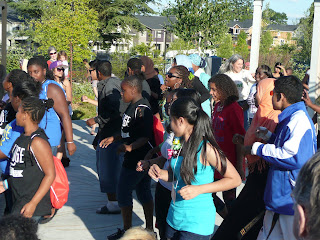Be Active Together (not to be confused with Altogether Better!) is a 5 year community based participatory research project (CBPR) in the High Point neighbourhood of West Seattle. The project is funded by the National Institute of Health and runs until 2013. The strapline for the project gives a clear clue as to what it’s about (see photo below):
I was keen to learn more so met with the Programme Director, Denise Sharify, who is based at Neighborhood House in High Point.
"Neighborhood house helps low income people become more self-sufficient. It seeks to build strong and vibrant communities where everyone feels attached. High point center is the home of anti-poverty services that strengthen families and support the development of a healthy, vibrant and green community." (taken from the Neighborhood House website)
Denise explained, that by taking a participatory research approach, the 'Be Active Together' project was a means of, “bringing together community and research worlds and involving communities as partners – so they have more ownership over the results.”
 |
| With Denise Sharify at Neighborhood House, High Point, Seattle |
Denise explained how the ‘Be Active Together” project is based on the basic notion that more activity equals better health.
Being ‘active’ in the terms of this project has two elements. It refers to being both physically active and also more politically active. So it’s not just about getting fitter, it’s about empowerment too.
The project began with a community impact survey which sought to help identify the barriers to being active (in both senses of the word), such as lack of access to physical activity opportunities, cultural and social barriers, financial barriers.
The project has since come up with a range of initiatives to help overcome these barriers. All activities are aimed at promoting better social networking as well as physical activity. Some of these things that have been offered are:
- Free exercise classes
- Social events
- Field and hiking trips
- Scholarships for youth sports programmes
- Gardening opportunities with the Market Garden
- Connections with other free or low cost physical activity sessions
Denise gave an example of how the project had helped to address some of the cultural barriers faced by some community members by arranging women only swim sessions for the Somali community. Denise told me how initially, the women would come and just stand in the water and chat (!) which may have helped meet their social needs but was not necessarily increasing physical activity levels! The women then identified the need for swimming lessons – so they could gain confidence and skills in the water. The women now contribute to the cost of the lessions which are subsidized by the project and Denise has a waiting list of people wanting to take part.
 |
| Young residents of High Point being active through dance at the Health Fair |
Other barriers to being active are being addressed through physical environmental changes. At a Community consultation event last year (led by Jim Diers), people were given 20 minutes to come up with a vision of , “what would an awesome High Point community look like?”. They were then invited to share their vision with others in the room. Denise told me, “people came up with all sorts of ideas for projects to make the community a better place.” One 6 year old boy (who Denise says she had never heard speak out before) stood up and said, very loudly; “I want swings. We need a swing set here.” Since that time, Denise has been able to secure funding for a new play park in the community – and so that little boy – and all his friends – will have their swings – another place they can ‘be active together’.
Be Active Together is also clearly about the promotion of community building and asset mobilisation by bringing neighbours together, connecting them to resources (assets) and building community leadership through Community Action Teams . These teams, made up of 6-8 volunteers, work with project staff to:
· Promote community activities and help provide the interventions
· Help connect neighbours with each other
· Advocate for healthy community
· Address health disparities
To help them in their role, the Action Team members are given some political advocacy training as well as support and mentoring to encourage empowerment. Denise told me how, “Members are stepping up and having a voice in the sort of system and environment change needed to sustain some the work”, e.g. lobbying for changes in pricing structures of parks and recreation dept facilities so that more people can access their services.
So people are becoming more physically active and more politically active. The evaluation of the process will seek to measure the impact on empowerment so will be sure to keep an eye out for the resullts.

No comments:
Post a Comment